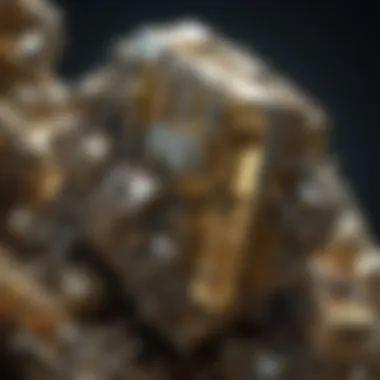An In-depth Journey into Rocks and Minerals: Expert Guide to Identification Techniques


Rock and Fossil Indetificiaton
In the realm of rocks and minerals, identification is a skill that sets enthusiasts apart. Understanding the types of rocks and fossils opens doors to a world of geological wonders. One must keenly observe the subtle characteristics unique to each specimen, honing the eye for detail and nuance. Right tools play a critical role in the identification process, aiding in precision and accuracy. From magnifying glasses to hardness testing kits, having the correct tools at hand is essential in the journey of exploration.
Collecting Tips and Techniques
Embarking on collecting rocks and fossils requires finesse and expertise. Best practices encompass a delicate balance between discovery and conservation, prioritizing the preservation of specimens and their natural habitats. Locating prime collecting sites involves research and fieldwork, tapping into geological maps and expert advice to uncover hidden treasures. Extraction of specimens demands patience and caution, ensuring minimal impact on the environment while securing valuable artifacts for study and appreciation.
Preservation and Display
Preservation techniques are crucial in maintaining the integrity of rocks and fossils for generations to come. Employing proper storage methods safeguards specimens from degradation, utilizing climate-controlled environments and archival materials for long-term conservation. Creative display ideas add a touch of artistry to showcasing collections, allowing enthusiasts to curate exhibits that highlight the beauty and diversity of their finds.
Geological Insights
Diving deeper into the geological aspects of rocks and fossils unveils a tapestry of ancient landscapes and processes. Examining geological formations offers insights into the Earth's dynamic history, unraveling the story of shifting continents and vanishing seas. The historical significance of rocks and fossils resonates through time, showcasing evolutionary milestones and climatic shifts. Notable discoveries in the field continue to reshape our understanding of the natural world, propelling scientific discoveries and captivating the imagination of enthusiasts worldwide.
Introduction
Understanding the Importance of Rock and Mineral Identification
Foraying into the realm of rock and mineral identification unveils a universe of knowledge and insights. Grasping this art offers a gateway to comprehend the Earth's evolution, from its fiery beginnings to the intricate geological processes shaping landscapes. Recognizing rocks and minerals is akin to deciphering Nature's ancient language, where every specimen narrates a unique story of formation, metamorphosis, and environmental conditions.
Benefits of Being Able to Identify Rocks and Minerals
Unlocking the ability to identify rocks and minerals brings a plethora of benefits, both intellectually and practically. From honing observational skills to fostering a deeper connection with the natural world, this expertise enriches one's perspective on geology and history. Moreover, distinguishing between different rock types aids in mineral exploration, construction materials selection, and even gemstone appreciation. The capacity to discern rocks and minerals adds a layer of fascination to everyday surroundings, turning mundane walks into geological adventures.
Physical Characteristics of Rocks


Exploring the world of rocks involves a meticulous examination of their physical characteristics. Understanding the physical attributes of rocks is crucial for identifying and categorizing them correctly in the vast realm of geology. The color and luster, texture and grain size, hardness, cleavage, and fracture are key elements that aid in differentiating one rock type from another. By honing in on these specific characteristics, rock and mineral enthusiasts can unravel the geological history embedded within each specimen.
Color and Luster
Color and luster serve as fundamental properties for rock identification. The hue and shine of a rock's surface can divulge important information about its mineral content and formation process. The color spectrum, varying from earthy tones to vibrant hues, offers insights into the presence of specific minerals. Luster, referring to the appearance of light reflecting off the surface, provides clues about the crystal structure and composition of the rock. By scrutinizing these visual cues, geologists and collectors alike can discern valuable details about the rock specimen under observation.
Texture and Grain Size
The texture and grain size of a rock play a pivotal role in distinguishing different rock types. Texture encompasses the overall appearance and feel of the rock surface, ranging from smooth and glassy to rough and grainy. Grain size refers to the size of mineral grains within the rock, shedding light on the cooling history and formation conditions. Analyzing these characteristics aids in classifying rocks into categories such as sedimentary, igneous, or metamorphic, offering profound insights into their geological origin and subsequent alterations over time.
Hardness
Hardness is a critical property used to evaluate a rock's resistance to scratching and abrasion. The Mohs hardness scale, ranging from talc (1) to diamond (10), provides a standardized method for comparing the hardness of different minerals. By conducting simple tests using common materials, such as fingernails or steel nails, geologists can determine the relative hardness of rocks. Understanding the hardness of a rock specimen can unveil details about its mineral composition and the processes that have shaped it over millennia.
Cleavage and Fracture
Cleavage and fracture characteristics offer essential insights into a rock's internal structure and how it breaks when subjected to external forces. Cleavage refers to the tendency of a mineral to break along certain planes, revealing its internal arrangement of atoms. Fracture, on the other hand, describes how a rock breaks irregularly when no cleavage planes are present. Observing these properties aids in identifying minerals and rocks, providing valuable information about their formation, crystalline structure, and geological significance. Examining cleavage and fracture patterns can help enthusiasts unravel the geologic mysteries concealed within rock specimens, fostering a deeper appreciation for the intricacies of Earth's geological processes.
Chemical Properties and Composition
Chemical properties and composition play a crucial role in the realm of rocks and minerals. By understanding the chemical makeup of rocks and minerals, enthusiasts can unveil valuable information about their origin, formation, and unique characteristics. Chemical analysis allows researchers to identify specific elements present in a sample, providing insights into its geological history and potential uses. Moreover, studying the chemical properties of rocks and minerals aids in mineral classification and facilitates the recognition of key mineral types. This in-depth exploration of chemical properties enhances the ability to differentiate between various rock and mineral types, expanding the knowledge base of enthusiasts seeking to deepen their understanding of the earth's composition.
Mineral Composition
Minerals encompass a diverse array of chemical compounds that form the building blocks of rocks. Understanding mineral composition is essential for rock and mineral identification as it reveals the fundamental constituents of geological specimens. Each mineral possesses distinctive physical and chemical properties that distinguish it from others, making mineral composition a crucial aspect of classification. By examining the mineral composition of rocks, enthusiasts can discern the unique characteristics that define different geological formations. This detailed analysis offers valuable insights into the geological processes that shape the earth's surface and provides a foundation for further exploration and study within the field of geology.
Identifying Minerals by Their Chemical Makeup
Identifying minerals based on their chemical makeup offers a sophisticated approach to rock and mineral classification. By analyzing the elemental composition of minerals, researchers can pinpoint the specific elements present within a sample, enabling accurate identification. This method of mineral identification relies on the distinctive chemical signatures exhibited by different minerals, allowing geologists to categorize specimens based on their unique molecular structure. Understanding how to identify minerals by their chemical makeup is a valuable skill that empowers enthusiasts to navigate the complex world of geological specimens with precision and expertise. By honing this proficiency, collectors can expand their knowledge base and contribute to the broader scientific understanding of rocks and minerals.


Rock and Mineral Testing Methods
The section on Rock and Mineral Testing Methods in this article is a critical component for enthusiasts seeking to delve deeper into the world of rocks and minerals. Understanding the physical characteristics alone may not suffice when it comes to accurately identifying different types of rocks and minerals. This is where testing methods play a pivotal role. By employing various testing techniques, enthusiasts can gather valuable data that aids in precise identification.
Use of Acid
One of the fundamental methods for testing rocks and minerals is the utilization of acid. Acid testing helps determine the reactivity of a specimen to different types of acids, providing clues about its composition. It is a straightforward yet insightful process where the reaction of the specimen with acid helps in identifying key characteristics such as carbonate content.
Magnetism Testing
Magnetism testing is another essential technique in the realm of rock and mineral identification. By subjecting specimens to magnetic fields, enthusiasts can categorize rocks based on their magnetic properties. This method is particularly useful in distinguishing between magnetic and non-magnetic minerals, offering valuable insights into their composition and classification.
Scratch Test
The scratch test is a versatile method widely used by geologists and enthusiasts to assess the hardness of rocks and minerals. By examining the resistance of a specimen to scratching, one can infer its hardness on the Mohs scale. This simple yet effective test provides valuable information for differentiating between minerals with varying hardness levels.
Density Testing
Density testing is a valuable technique employed in identifying rocks and minerals based on their mass per unit volume. By measuring the density of a specimen, enthusiasts can discern important details about its composition and structural integrity. This method offers insights into the overall density variations among different rock and mineral types, aiding in accurate identification and classification.
Common Types of Rocks and Minerals
In this comprehensive guide on exploring the world of rocks and minerals, understanding common types is crucial. Common types of rocks and minerals play a pivotal role in geological studies and practical applications. By delving into sedimentary, igneous, metamorphic rocks, and key mineral types, individuals can grasp the earth's history, formation processes, and various industrial uses. These classifications serve as the foundation for further geological exploration and scientific research. Identifying these common types aids in recognizing environmental patterns, mineral resource identification, and understanding geological formations, providing valuable insights into the Earth's evolution.
Sedimentary Rocks
Sedimentary rocks form through the accumulation of sediment over time, reflecting environmental changes and geological processes. Understanding sedimentary rocks offers clues about past climates, land formations, and fossil preservation. By examining sedimentary structures, such as bedding, cross-bedding, and fossils found within, geologists can decipher Earth's history and ancient environments. This knowledge is vital for reconstructing past landscapes, identifying fossil fuel reservoirs, and analyzing the erosion and deposition cycles that shape our planet.


Igneous Rocks
Igneous rocks originate from the cooling and solidification of magma or lava. These rocks provide insights into Earth's internal processes, volcanic activities, and crustal movements. By studying igneous rocks, scientists can determine the temperature and pressure conditions at which they formed, uncovering details about Earth's mantle and tectonic plate movements. Igneous rocks are valuable for mineral exploration, understanding volcanic hazards, and assessing geological hazards associated with magma chambers and volcanic eruptions.
Metamorphic Rocks
Metamorphic rocks undergo changes in texture and mineral composition due to high heat and pressure within the Earth's crust. These rocks offer evidence of regional metamorphism, contact metamorphism, and tectonic forces acting upon the Earth's crust. By analyzing metamorphic rocks, geologists can unravel the geological history of mountain building, subduction zones, and plate collisions. Metamorphic rocks are significant for uncovering ancient continental collisions, determining geothermal gradient variations, and identifying mineral deposits associated with metamorphic processes.
Key Mineral Types
Key mineral types encompass a diverse range of minerals that hold economic value, scientific interest, and industrial significance. From silicates to carbonates, sulfides, and oxides, these mineral groups contribute to construction materials, energy production, gemstone industry, and chemical manufacturing. Understanding key mineral types aids in mineral exploration efforts, mining operations, and gemology research. By recognizing key mineral properties and occurrences, individuals can assess mineralogical diversity, geological formations, and the economic viability of mineral deposits.
Tools and Equipment for Rock and Mineral Identification
In the realm of rock and mineral identification, having the right tools and equipment is paramount to ensure accurate and efficient analysis. These tools not only aid in the identification process but also provide valuable insights into the composition and structure of different specimens. Without the proper tools, enthusiasts may struggle to decipher key characteristics, hindering their ability to differentiate between various rock and mineral types.
One of the essential instruments for rock and mineral identification is the hand lens. This tool enables enthusiasts to observe minerals' color, shape, and texture up close, allowing for detailed examinations of specimen features. Additionally, the hand lens helps in identifying specific mineral properties such as cleavage, fracture, and crystal form. Its compact size and magnifying capabilities make it a versatile tool for fieldwork and laboratory analysis.
Next in line is the streak plate, a valuable tool used in determining a mineral's streak color. By rubbing a mineral sample across the streak plate's surface, enthusiasts can observe the color left behind, which may differ from the mineral's external appearance. This method aids in distinguishing between minerals with similar outward characteristics but distinct streak colors, offering crucial insights into mineral identification.
Lastly, the geologist's hammer stands as a fundamental tool for rock and mineral enthusiasts, facilitating the collection of samples for analysis. With a sturdy hammerhead for breaking rocks and a sharp pick for precise extraction, the geologist's hammer is indispensable during fieldwork expeditions. Its durable construction ensures longevity in various geological environments, making it a reliable companion for rock and mineral identification endeavors.
Investing in quality tools and equipment for rock and mineral identification is a wise choice for enthusiasts looking to deepen their understanding of geological specimens. These instruments not only enhance the identification process but also enrich the overall experience of exploring the captivating world of rocks and minerals.
Conclusion
The final section of this comprehensive guide on Exploring the World of Rocks and Minerals is dedicated to emphasizing the criticality of continuous learning and practice in honing one's skills in rock and mineral identification. Understanding the significance of ongoing education and field experience is paramount for enthusiasts, as it not only refines their abilities but also deepens their appreciation for the geological world. By engaging in continual learning, individuals elevate their proficiency levels, enabling them to discern subtle differences in rocks and minerals that may go unnoticed by novices. Moreover, sustained practice instills confidence and competence, essential qualities for accurate identifications and interpretations. Embracing the ethos of lifelong learning ensures that rock and mineral enthusiasts remain at the forefront of developments in the field, offering a rewarding journey of discovery and mastery.
Summary of Key Points
In this segment, we reflect on the essential elements covered throughout this guide, encapsulating the core tenets for identifying rocks and minerals effectively. It highlights the pivotal role of key physical characteristics such as color, luster, texture, hardness, cleavage, and fracture in distinguishing between different rock types. Furthermore, exploring the chemical properties and composition of minerals unveils a deeper understanding of their distinctiveness. The utilization of various testing methods, including acid tests, magnetism assessments, scratch tests, and density examinations, equips enthusiasts with practical tools for accurate identifications. Delving into common rock classifications, including sedimentary, igneous, and metamorphic rocks, along with key mineral types, expands one's knowledge base. Additionally, the significance of employing specialized tools like hand lenses, streak plates, and geologist's hammers is underscored in enhancing precision during identification processes.
Importance of Ongoing Learning and Practice
Evolving one's expertise in rock and mineral identification necessitates a commitment to continuous learning and deliberate practice. By immersing oneself in the diverse realms of geology, enthusiasts cultivate a nuanced understanding of the earth's composition and geological processes. Embracing ongoing learning opportunities, such as workshops, field expeditions, and academic courses, cultivates a culture of curiosity and exploration within the community. Concurrently, consistent practice through fieldwork and laboratory analyses sharpens observational skills and fosters a deeper connection with the natural world. The notion of perpetual learning serves as a beacon for enthusiasts, guiding them towards unraveling the mysteries encapsulated within rocks and minerals, shaping them into adept connoisseurs of the geological domain.







